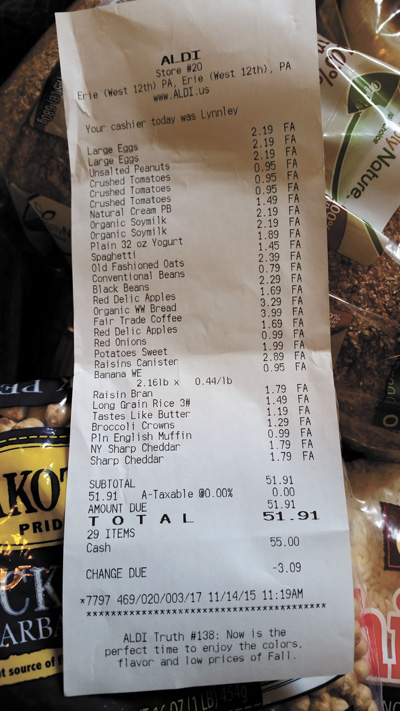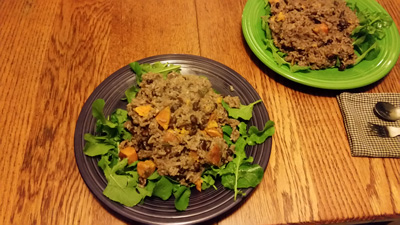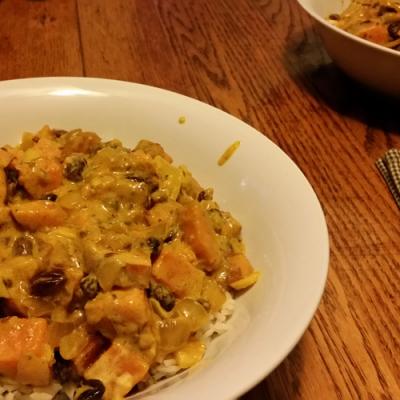Emotional Eating
The S.N.A.P. Challenge puts hunger in perspective, both on and off the plate.
We're sitting in the Giant Eagle parking lot. At my feet is a bag containing only a small chocolate cake and a pint of absurdly expensive gelato.
This isn't food we'd typically eat. We know what it'll do to our bodies. But it's been a long week and we're feeling indulgent.
So we can't wait to dig into the fatty sugar-laden not-quite-food we've gathered. But this time is different. Because we'll be starting the S.N.A.P. Challenge tomorrow.
According to Second Harvest Food Bank of Northwest Pennsylvania, which services 167,700 people throughout northwest Pennsylvania, "The S.N.A.P. Challenge is a small glimpse into the life of an individual or family living off of the monthly stipends provided by the federal government's Supplemental Nutrition Assistance Program (S.N.A.P.), formerly known as food stamps."
Challenge participants "live off of the stipend provided per person per day to purchase food and drink items," Second Harvest continues. "The monthly allotment is determined by the USDA. For the state of Pennsylvania, the average monthly benefit is $119.41. This works out to $3.98 per day for a month consisting of 30 days."
Four dollars per day, per person. Certainly changes the way you look at a latte.
The S.N.A.P. Challenge has made media rounds for the last few years, thanks to celebrities like Gwyneth Paltrow, Panera Bread founder and CEO Ron Shaich, and Newark Mayor Cory Booker taking it on. But I learned of it in Second Harvest's October newsletter, which featured staffer Amanda Johnson's thoughtful and nuanced journal of the experience.
Johnson writes of persistent headaches, nagging stomachaches, sluggishness, and difficulty focusing. "Things that would take me mere minutes to do on a normal day took two or three times longer to accomplish," she recalls.
My husband and I had the luxury of deciding when it would be easiest for us to take the Challenge; when, in other words, we didn't have too much planned that might be inhibited by feeling like crap and being exhausted.
But inconvenience is the essence of poverty. And though seven days is hardly enough to genuinely experience the depth of that inconvenience, at least it's an insight.
So we're walking through Giant Eagle on Challenge Eve with entirely new eyes. This isn't our Challenge shopping trip, which we'll embark on the next day at Aldi. We're really just here for dessert. But it's hard to ignore all we suddenly won't have access to.
The produce section – where we normally spend inordinately – is virtually off limits. Forget organic. Forget things like mushrooms, which – though we adore them – don't offer nearly enough nutritional bang for the buck. Forget walnuts – which are nutritionally dense but far too expensive. Forget anything pre-cut or bagged, which would save time but squander money.
We head past prepared foods to the bakery. It's 8 p.m. on a Friday, and tons of food remains. A sea of pre-made salads and grab-n-go options beckon no one. Loaves of "artisan" bread (whatever that means anymore), dozens of cupcakes, racks of donuts and cakes and cookies. Stores donate some of their leftover food, but this is almost too much to comprehend. And inevitably, piles of it will be trashed.
A Harvest Public Media story in September of 2014 reported that "A full 10 percent of the available food supply in the U.S. is wasted every year at the retail level, according to the U.S. Department of Agriculture, and about 20 percent is wasted at home. That's food worth more than $160 billion. And it's food that could go toward feeding the estimated one in seven American households that can't find enough to eat."
After our shameful purchase – which costs almost half of what someone relying on S.N.A.P. benefits could spend in a week – we get into the car, imagining mountains of untouched food being dumped.
"Let's just spend the money on alcohol and go dumpster diving for the week," says my husband.
He's joking. But it's no wonder some people make this choice.
If you're truly enduring poverty, you may want escape. Relief. Or to numb out.
Linda Tirado, author of Hand to Mouth: Living in Bootstrap America, explores this need, and how poor people are not-so-subtly judged for it.
"We all cope in our own special ways," Tirado writes. "I smoke. My friend drinks. In fact, I'm highly confident in betting that you and many of your friends cope by drinking as well. Come home from a long day at work, and what do you do? Pop open a beer? Or a bag of potato chips? Or maybe you take a Valium when you're feeling stressed out.
"Why are other people's coping mechanisms better than poor people's?" Tirado continues. "Because they're prettier. People with more money drink better wine out of nicer glasses. And maybe they get a prescription for benzodiazepines from their own personal on-call psychiatrist instead of buying a pack of cigarettes. They can buy whatever they like and it's OK, because retail therapy is a recognized course of treatment for the upper classes. Poor people don't have those luxuries. We smoke because it's a fast, quick hit of dopamine. We eat junk because it's cheap and it lights up the pleasure centers of our brain."
I've heard the argument that people on food benefits shouldn't be allowed to eat junk. I'm ashamed to say that I've probably even agreed.
But three things strike me above all others while on the Challenge: how much I take food for granted as a source of immediate gratification, how much I rely on a variety of flavors to please me, and how deep the embedded ruts of privilege really are. People who have never had to rely on S.N.A.P. don't get it. And can't. Thus, this experiment of ours is absurd in so many ways. And yet, even flawed empathy is a powerful tool for transformation.
 Our S.N.A.P Shopping Trip
Our S.N.A.P Shopping Trip
We head to Aldi with our $56 combined allotment. Because we're pooling our resources, we can afford a bag of rice, two bags of beans, and a giant canister of oatmeal – a lot of sustaining nutrition – and still have money for other staples.
One revealing element is this: I have primarily consumed gluten free, no dairy milk diet for years. If your impulse right now is to stop reading in disgust, I assure you that mine might be the same. These dietary limitations are self-imposed, but they're not so I can host one of those self-righteous "Here's how I've perfected my diet and so can you (if you pay me)!" blogs. Rather, they're the result of determining what makes me feel physically okay when I eat it, and what doesn't.
And the fact that I'm lucky enough to have a choice.
On "S.N.A.P.," I'm eating wheat bread and pasta. I've purchased soy milk for my oatmeal, because I know dairy milk doesn't agree with me. But soy doesn't feel too great, either. So I'm a little nauseated, all of the time.
This is for one week. But food sensitivities can create long-term autoimmune effects. And poor people can't afford to be "food intolerant," which especially impacts poor children. So they go to work (if they're lucky) or school and feel a little sick or lethargic, all of the time. Not the ideal way to earn a promotion or good grades.
Johnson explores this in her post from Challenge Day 3, where she considers how a child's hunger might negatively affect everything from attendance to learning to behavior. But, she stresses, "the child is not to blame. They do not have control over their situation or circumstances."
Nor do most people on S.N.A.P. or other benefits. But negative stereotypes persist. "They have been called lazy and unmotivated, accused of 'cheating the system' or 'looking for a free handout,'" Johnson explains. "There is the mindset of 'why should my hard earned tax dollars go to support them when they don't even have a job?'"
Johnson acknowledges that a few work the system, but "With poverty, there are many circumstances that could cause someone to turn to a food bank or the government for assistance. There is no 'right' or 'wrong' need for food; food is a basic necessity that should be available to everyone."
But it's not. At least not without aid. In a 2014 study, Feeding America reports that "Approximately one out of four people in northwest Pennsylvania receives food from the Second Harvest Food Bank network each year."
Some S.N.A.P. recipients, as Johnson recognizes, "may also have access to other means to acquire food … but for a lot of recipients, the monthly allotment is all they have."
Johnson breaks down S.N.A.P. benefits according to USDA specifications. She calculates that a three-person family's "monthly S.N.A.P. allotment is $227, which is roughly $2.52 per person per day.
"Based off of the most recent hunger study conducted by Feeding America for Second Harvest," Johnson adds, "85 percent of households served by Second Harvest programs and S.N.A.P. recipients say their S.N.A.P. benefits do not last them for an entire month. These families are then dependent on their local food pantries, soup kitchens, friends, family, and any other government assistance they may be eligible for to fill in the gaps. More often than not it is simply not enough."
 The hidden perks of privilege
The hidden perks of privilege
More incongruities reveal themselves as we stock up for our Challenge. We can drive to Aldi. We don't have to take the bus, then haul unwieldy bags from the stop to our home. Our permanent home. Which we own.
We also own a pressure cooker: an incredible device that pulls together any variation of dried beans and rice in about 20 minutes. These tools are heralded for their ability to save owners money in the long run. People on S.N.A.P., though, wouldn't likely own one. Feeding America reports that 5 percent of those served by Second Harvest don't even have cooking facilities. Or a refrigerator.
Tirado addresses this. "I know how to cook," she begins. "I had to take Home Ec to graduate from high school. … You have to have a working stove, and pots, and spices, and you'll have to do the dishes no matter how tired you are or they'll attract bugs. It is a huge new skill for a lot of people. That's not great, but it's true. If you fuck it up, you could make your family sick."
So that could be one reason why many families in poverty fill their carts with ready-made, processed food.
We realize we don't have the money to buy in bulk – which would save a lot – nor does Aldi have bulk bins. But the coffee we buy is certified Fair Trade, unlike the canned tomatoes or fresh apples, bananas, sweet potatoes, broccoli, or onions. As ample recent evidence shows, the working conditions of those harvesting this low-cost produce make Steinbeck's The Grapes of Wrath read positively modern.
In short, if you're poor, ethical food standards you hold dear must be back-burnered in the name of what you can afford. Imagine all of the guilt-inducing messages proliferated by advertisers, suggesting that mothers are terrible if they don't feed their children purely organic foods. And the shame in not being able to afford them.
A Distressing Diet
During our S.N.A.P. week, we freely eat anything grown in our backyard. Thus – in mid-November – we have ample arugula, lettuce, swiss chard, garlic, and herbs, plus a few green tomatoes. We don't do this to cheat; rather, to demonstrate that growing your own food – even in a community garden or on a windowsill – helps to secure nourishment. Not everyone has access to this opportunity but everyone should. It's really that simple.
Beyond that, we eat fairly well, since we'd left a $4 cushion in our allotment for olive oil and spices. But we still become terribly sick of our limited options. And – though we aren't starving – we never quite feel satisfied. By night six we're on the couch with two spoons and the remains of our peanut butter. Maybe we just want to eat something without worrying so much.
The day after the Challenge, we stock up at our usual Wegmans. The simple act of choosing what we want engenders conflicting feelings of giddiness and guilt. It's disconcerting.
Here's how I'd sum up the feeling of simulating S.N.A.P. life, even just for those seven days: You constantly dread running out of food. You can't relax. You're preoccupied. You're scared.
And you're always on the outside looking in.
I ride the bus, and my route passes inviting restaurants on South Park Row and convivial bars on State Street. On evenings during the Challenge, I ride by those cafe windows and am consumed by a sense of longing and not belonging.
Our culture overwhelmingly pushes food as a way to indulge oneself; to provide relief and reward, to celebrate. If you're poor, you don't get to participate. I don't think it's a stretch to say that the poverty that denies people food choices likewise denies them validating membership in this food-obsessed society we've created.
Many of us will make resolutions for 2016. Many of those will be about eating less. But in America, we waste food exorbitantly while millions go hungry.
Millions.
Maybe it's time we asked ourselves – when we're summoning the willpower to resist yet another indulgence – what exactly we're all so hungry for.
For more information about the S.N.A.P. Challenge, including Amanda Johnson's online journal, or ways to become involved with Second Harvest Food Bank's efforts, visit nwpafoodbank.org.
Katie Chriest can be contacted at katie@ErieReader.com.


.png)


